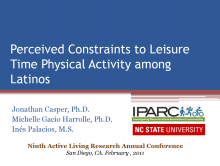We are pleased to announce an exciting new alliance between Active Living Research and GP RED to co-host and coordinate...
Perceived Constraints to Leisure Time Physical Activity Among Latinos

Presentation at the 2011 Active Living Research Annual Conference
Background:
The prevalence of obesity disproportionally affects Latino populations. This trend is largely attributed to Latinos living in communities that encourage unhealthy food choices and discourage physical activity. Given the immediate and long-term benefits of physical activity (PA), identifying constraints to PA among Latinos is an important research need. Past research has identified factors that limit PA among Latinos to be issues such as accessibility, care giving, lack of knowledge, time, safety or fear of crime, and facilities issues. While considerable research has focused on identification of constraints to PA, few have compared the relative importance of constraints among Latino populations (e.g., is time constraints perceived higher than accessibility constraints?).
Objectives:
The objectives of our study were to (1) examine and compare perceived constraints to PA among Latinos; and (2) compare constraints based on self-reported leisure time physical activity (LTPA), age, gender, and income categories.
Methods:
In partnership with El Pueblo, a NC non-profit advocacy organization for Latinos, we collected data through Latino community leaders (promotores) who distributed questionnaires to local Latino constituents. The participants (N = 277) completed a paper-pencil questionnaire with an 89% return rate. Participants’ ages ranged from 18 to 69 (M = 34.8), 69% were female, the majority of the participants was married (62%), had at least a high school education (58 %); were first generation immigrants (73%), with the highest frequency from Mexico (44%).
The leisure constraints instrument included 20 items assessing seven types of constraints (accessibility, facilities, knowledge, partners, psychological, safety, and time) on a 5-point Likert-type scale (5 - strongly agree to 1 - strongly disagree). Constructs representing the constraint types have been validated by factor analysis in multiple PA settings. PA was measured by the Stanford Brief PA Survey. Responses to the measure were used to categorize leisure time activity levels: 1) inactive (n = 149); 2) light-inactive (n = 36); 3) moderate (n = 56); 4) hard (n = 22); 5) very hard physical activity (n = 6). Scale assessment showed normal distributions and acceptable internal reliability (Cronbach alphas; .86 - .65).
Results:
The majority of respondents (81%) indicated that they would like to be more physically active. The descriptive analysis showed that lack of knowledge about PA in the community (M = 2.8) was rated the highest followed by access to PA (M = 2.8), partners (M = 2.7), time (M =2.7), facilities (M = 2.6), psychological (M = 2.4), and safety (M = 1.1). MANOVA results showed a significant difference among LTPA levels [Wilks’ Λ = .72, F(35, 1012.02) = 2.36, p < .001, η = .06]. Group differences were significant for psychological constraints (p = .004, η = .07), knowledge of PA (p < .001, η = .13), access (p = .001, η = .08), partners (p = .001, η = .07), and safety (p = .01, η = .06]. However, group differences were not significant for facility (p = .676, η = .01). Significant differences were found among the levels of income [Wilks’ Λ = .18, F(21, 657) = 2.0, p = .005, η = .06]. Group differences were significant for psychological constraints (p = .047, η = .04) and for safety (p = .048, η = .04]. Group differences were not significant for all other variables. The MANOVA results showed no significant differences among age [Wilks’ Λ = .06, F(21, 723) = .69, p = .85, η = .02] and gender [Wilks’ Λ = .05, F(7, 241) = 1.87, p = .08, η = .05].
Conclusions:
The data showed that while a majority of respondents want to be more physically active, constraints such as a lack of knowledge about places and programming and lack of opportunities due to transportation, money, or location may hinder PA. These results differ from studies of non-Latinos where constraints such as time and facilities have been rated higher in PA settings using a similar measure (e.g., Tsai & Coleman, 2009). Segmentation based on PA showed that constraints rated low overall (psychology and safety) were significantly important for those participants with lower LTPA. The differences comparing demographic segments found that lower income respondents felt less confident participating in PA and safety was a greater concern. Based on the data, policy measures specific to Latinos may include marketing materials that emphasize locations and programming, introductory programming dedicated to those less active, programming supporting participation with partners, and transportation to PA opportunities.
Support:
This study was funded by a grant from IPARC a research initiative of the Department of Parks, Recreation and Tourism Management at NC State University.
STAY UP TO DATE
RECENTLY ADDED TOOLS & RESOURCES
MOVE! A BLOG ABOUT ACTIVE LIVING
The "Active Living Conference" aims to break down research and practice silos and...







